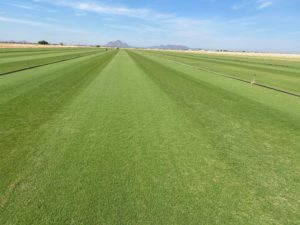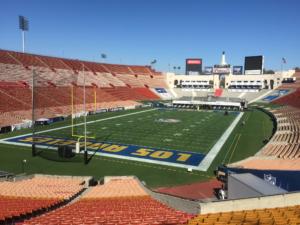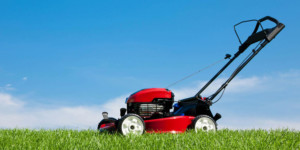Nov
You Have Overseeded Your California or Arizona Sod Lawn–Now What? And….Even if You Haven’t.
By now, most of you who are going to overseed your California or Arizona sod have either begun the process or have had your seed down for a few weeks. Today, I want to discuss what to do now that you have the ryegrass growing and cooler temperatures are on the horizon.
Getting your ryegrass up and growing is obviously the first step to a successful winter lawn, but what about maintenance? How can you make sure your ryegrass is strong going into the winter and you will have a full stand of ryegrass once the temperatures begin to drop into the 40’s at night? There are several key items associated with a strong winter lawn but early preparation should be high on your list.
I know you put down a starter fertilizer with your seed but let’s remember that fertilizer will move freely in a saturated soil. The new plant took up most of the nutrients from the starter fertilizer application but the residual affect is limited because you’ve been keeping the seed wet for the past few weeks. So what exactly does this mean? Basically, what I’m trying to say is that once you’ve had your ryegrass lawn in for 2-3 weeks I would advise getting a second fertilizer application on the grass.
Comments Off on You Have Overseeded Your California or Arizona Sod Lawn–Now What? And….Even if You Haven’t.Oct
Frequently Asked Questions About Overseeding Your Warm Season Lawn
Now that we’re into October it’s time to get the overseeding of your warm season grass process started. I wanted to pass along some of the most frequently asked questions during this time of the year.
When is the best time to start overseeding?
Ideally overseeding should be done when nighttime temperatures are consistently in the 60’s. Usually this will be in October. There will be some higher and lower than normal temperatures, but anytime during October is good.
How low do I need to scalp the grass prior to seeding?
Height of cut isn’t as important as opening the turf canopy. The shorter you mow the grass, the tighter the turf canopy will be which will result in the need to verticut more aggressively. I recommend not going lower than ½”. There is no need to take the lawn to the dirt or you will cause long term problems to the grass plant.
Sep
Invierno, siembre su césped de Arizona
A medida que nos acercamos al final del verano, los equipos de cuidado del césped se están preparando para una siembra excesiva y para mantener la hierba verde durante el invierno.
Primero, analicemos la preparación inicial del césped. Deje que su césped crezca un 25-30% de altura para proporcionar más densidad de hojas. Otra ventaja de mantener su césped a una altura más alta es que usará menos agua, y cuando le corte el cuero cabelludo le dejará muchas hojas nuevas y saludables para la primavera. Si tiene un césped saludable, es bueno pasarle el rastrillo ligeramente o cortarlo verticalmente en ese momento. Esto abre el dosel del césped y permite que las semillas lleguen al suelo. Si normalmente mantiene su césped a 1 “, podrá elevar la altura de su césped durante las próximas dos semanas a alrededor de 1.25″. Cuando el clima coopere, puede cortar el césped ligeramente por debajo de su altura de corte normal. La mayoría de los cortacéspedes rotativos se pueden bajar a ¾ ”.(Tres cuartos).
Recuerde que no todas las semillas son iguales. Aquí hay algunos consejos a tener en cuenta al mirar una bolsa de semillas.
1. El mejor material para la siembra de invierno es el ryegrass perenne (Hierba de centeno perenne). Si bien parece que la “Anual de hierba de centeno tiene sentido”(Anual ryegrass), este no tiene el vigor, el color o la densidad que tiene la hierba de centeno perenne.
2. Tasa de germinación: la tasa de germinación le indicará qué cantidad de semilla es viable. Si recoge una bolsa con una tasa de germinación del 60%, entonces necesita un 40% más de semillas para dejar la tasa correcta. Tiene que encontrar una bolsa con más del 85% de germinación.
3. Semilla de malezas: este número debe ser cero. Cualquier semilla de
marihuana o materia inerte causará estragos en su césped sobre el sembrado.
4. Muchas veces las semillas de ryegrass (hierba de centeno) mezcladas son más baratas porque ponen diferentes grados de semillas en la bolsa. Algunas mezclas son semillas muy buenas y proporcionan diferentes protecciones para las plantas, pero algunas se mezclan con semillas de menor grado. Recuerde que la semilla de ryegrass (hierba de centeno) tiene un precio por germinación, semilla de malezas y calidad de la semilla. Por lo tanto, si ha encontrado un acuerdo sobre semillas, no siempre será su mejor apuesta.
Materiales para Siembra excesiva.
Semilla de ryegrass perenne (Hierba de centeno perenne) de alta calidad.
Fertilizante inicial: cuando recoja su semilla, también recoja un fertilizante inicial. Algunos buenos son Soil Burst 4-4-2, 11-52-0 o 6-20-20.
Segunda aplicación de fertilizante: se puede aplicar después de cortar el césped por primera vez. Los fertilizantes a considerar son 21-7-14, 11-52-0 o 6-20-20.
Todos sus rociadores deben estar funcionando y ajustados adecuadamente. Revise todas las boquillas después del cuero cabelludo en busca de astillas o abolladuras que el cortacésped pueda haber causado al cortar más.
Rastrillo eléctrico o verticutter.
Instrucciones para Siembra excesiva.
1. Reduzca el agua un 25% dos semanas antes de la siembra excesiva. Detenga todas las aplicaciones de fertilizantes cuatro semanas antes de la siembra.
2. Eleve la altura de su césped 25-30%. Usted hace esto para que corte el césped desde el cuero cabelludo y no lo esté cortando desde la tierra, sino que esté cortando el césped a una altura manejable, lo que no causará ninguna lesión al césped en la primavera.
3. Rastrillo eléctrico o verticut el césped. No configure la máquina para desenterrar nuevos rizomas del suelo. Su objetivo es abrir el dosel de césped.
4. Después de encender el rastrillo, corte los recortes. El cortacésped funciona muy bien para recoger el césped. A continuación, configure el rastrillo eléctrico en una configuración más baja y realice el mismo proceso en una dirección diferente. Esto abrirá el dosel de césped denso y permitirá que la semilla ingrese a la planta de la hierba.
5. Corte los recortes nuevamente. Después de que se hayan limpiado los recortes, ajuste su podadora a ¾ ” (tres cuartos) o ½” (un medio) si tiene una cortadora de carrete y corte el césped. La única razón por la que está descalcificando es para evitar que el césped de la temporada cálida compita con la semilla de ryegrass (hierba de Centeno).
6. Tan pronto como limpie el césped, aplique su fertilizante de arranque. Estás buscando una aplicación de fósforo para ayudar a la semilla. Algunos excelentes fertilizantes son 4-4-2, 6-20-20 o 11-52-0 para comenzar con su césped.
7. Me gusta mantener mis rocas y bordes limpios, así que uso un separador de gotas. Primero aplique ryegrass perenne (hierba de Centeno perenne) a 10 libras por 1000 SF alrededor del perímetro del césped. Haga dos pases para asegurarse de que el esparcidor giratorio no arroje semillas a las rocas. Esto no es necesario, pero evitará que el ryegrass (la hierba de Centeno) invada áreas indeseables durante todo el invierno.
8. Luego aplique su hierba de centeno perenne con un esparcidor giratorio a 10-12 libras por 1000 SF al resto del césped. Si desea la mejor cobertura, debe aplicar 5-6 libras de semilla por 1000 SF en dos direcciones. Este es siempre el mejor enfoque, pero nuevamente no es necesario.
9. Tendrá algo de semilla encima de la superficie del césped, pero la mayoría debería estar dentro de la planta de césped si preparó su césped correctamente y abrió el dosel. Puede usar una escoba para ayudar a que cualquier semilla adicional ingrese a la planta.
10. Siga las instrucciones de riego a continuación.
Algunas personas cubren sus semillas con mantillo, pero puede ahorrar su tiempo, dinero y el olor en su jardín porque esto no es necesario. El mantillo permite que la semilla mantenga la humedad y mantiene el calor en la planta, pero si siembras en septiembre / octubre, hace mucho calor. No necesita preocuparse por la humedad tampoco. El mantillo no evita que las aves coman su semilla e incluso si ellas comen algo de semillas, usted ya ha aplicado muchas semillas con la tasa de 10-12 libras / 1000 SF.
Regar tu césped cubierto.
Semana 1-2: Riegue 3 veces al día durante 5-7 minutos por ciclo. Asegúrate de no tener estanques. Si lo hace, baje la cantidad de agua. Sugiero regar alrededor de las 8 a.m., mediodía y 4 p.m.
Semana 3: Riegue 2 veces al día durante 12-15 minutos. Dado que la planta es muy nueva en este momento, lo mejor es una aplicación por la mañana y por la tarde. Por lo general, puede cortar el césped por primera vez después de 14 días. Es mejor dejar que la hierba se seque durante varias horas antes de hacer el primer corte. Mantenga el cortacésped a una altura superior a la normal.
Semana 4: agua 1 vez por día durante 10-15 minutos. Durante este período de tiempo, puede cortarlo cada 5-7 días.
Semana 5: Riegue cada dos días 10-15 minutos. Corte el césped cada 5-7 días según sea necesario y aplique una vez más Soil Burst 4-4-2, 21-7-14 o 15-15-15.
Semana 6 y más allá: Riegue cada 2-3 días según sea necesario hasta que las temperaturas se enfríen durante el invierno. Durante el invierno, puede estirar su ryegrass (Hierba de Centeno) aún más entre riegos. Sugeriría aplicaciones de fertilizantes cada 28 días durante el otoño. Cuando las temperaturas caen alrededor del punto de congelación, es mejor usar fertilizantes líquidos para mantener el vigor del césped.
Jay Danek
Mr. Wise Grass
11803 E. McDonald Drive
Scottsdale, AZ 85256
480-951-8700
www.westcoastturf.com
Sep
Winter Overseeding Your California and Arizona Sod Lawn
We often see overseeding your warm season California or Arizona sod lawn as a process that should be done in a weekend. For some this may be the most convenient way to prep but for others its okay to take a week or two to complete the process. Trying to knock it all out in one weekend can result in some really long days out in the heat. My suggestion is to slowly start the process now so in a couple weeks when the overseed window opens you’re ready to go and won’t be wasting your entire Saturday on the lawn. Remember that the ideal window is when nighttime temperatures are in the 60’s. We’re currently sitting in the high 70’s so I would expect a couple more weeks. To follow overseed instructions scroll to bottom of this blog.
Prepping for overseed is often a large ordeal, but starting the process gradually can eliminate a lot of headaches. I want to reiterate something I have said for the past few years. The height of the grass is not associated with a quality overseed. In other words, scalping the grass down to the dirt does not guarantee good results, but opening up the turf canopy does. The shorter you mow your lawn the tighter the leaf blades become making it harder to get the ryegrass seed into the plant. If the seed is lying on the surface it will be slow to germinate and much of the seed will be lost. The seed needs a base to grow out of, and getting inside the grass plant allows for perfect moisture, heat, and a solid growing medium. This is why it’s so important to have a good warm season grass base. If you have a new lawn or a weak summer lawn it can have a direct impact on your overseed. The seed will establish much faster inside a healthy grass stand than it will on bare dirt.
Comments Off on Winter Overseeding Your California and Arizona Sod LawnSep
Pre-Overseeding Tips for Your Lawn
I would like to start by congratulating everyone on making through another California and Arizona summer. I know we still have a couple months of triple digit temperatures, but the worst should be behind us at this point. As we move into September our morning temperatures will start to feel less painful, but remember your warm season grass is loving this weather–especially your California and Arizona sod. I have started to field questions regarding fall overseeding and I want to tell you to hit the brakes. Don’t just tap the brakes, slam on the brakes. You will see ryegrass hit the stores in the next week but walk away or buy it and sit on it until temperatures really drop. Today I want to discuss prep for the fall, and how to get your grass ready to overseed. This won’t be a tutorial on how to overseed, but instead some pointers of what to do before you overseed.
Comments Off on Pre-Overseeding Tips for Your LawnMay
West Coast Turf – Official Turfgrass Providers to the Arizona Diamondbacks
Apr
Arizona Sod Mower Maintenance
While technically the calendar says spring, it feels like summer here in the valley of the sun. As we go through the transition period in California and Arizona from ryegrass back to bermudagrass or paspalum I want to touch a little bit on getting your mower ready for the season. It’s always a good idea to start each season off with a clean, sharp, and ready to use mower. There is nothing worse than going out to cut your lawn and pulling on the lawn mower cord a dozen times only to find the mower won’t turn over. There are some simple things you can do to keep it running well and last for several years.
Before I go into maintenance of your mower I will touch on the two different types of mowers on the market. You can choose between a rotary mower and a reel mower. The reel mowers I will refer to will be self-propelled mowers instead of push reel mowers. The reason I’m skipping on the push reel mowers is because it’s tough to push through thick bermudagrass during the summer months. While it can definitely be done, its just not my favorite thing to do on a 115-degree Arizona day.
There are several brands of reel mowers on the market so deciding which one to buy is going through the various options and deciding what is most important to you. Some of these choices include desired height of cut, number of reels on the mower (the mower reels, the tighter you can mow), weight of the mower, cutting width, and deciding if you will be collecting clippings or letting them lay on the ground. Most of the new reel mowers have a front bucket attachment but there are still a few on the market that drop clippings out the back of the mower.
Comments Off on Arizona Sod Mower MaintenanceSep
California and Arizona Sod Tips: It’s ALMOST Time to Overseed Your Lawn!
With the recent heavy rains and slightly cooler temperatures no doubt people are thinking about overseeding their California and Arizona lawns. While the calendar says September 18th and you will surely see people overseeding, I suggest you wait a few weeks. Follow my California and Arizona sod tips for a beautiful lawn. Overseeding does not need to be a one day process. You can begin the process a little early. Then, when temperatures are in the 60’s at night, you will just need to give your lawn one last haircut, drop the seed and begin watering.
Preparing to Overseed
Prepping for overseed is often a large ordeal. By starting the process gradually you can eliminate the headaches associated with trying to do it all in one afternoon. I want to reiterate something I have been saying for the past few years. The height of the grass is not associated with a quality overseed. In other words scalping the grass down to the dirt does not guarantee good results. Opening up the turf canopy does.
The shorter you mow your lawn the tighter the leaf blades become. This makes it harder to get the ryegrass seed into the plant. If the seed is lying on the surface it will be slow to germinate and much of the seed will be lost. The seed needs a base to grow out of. Getting inside the grass plant allows for perfect moisture, heat, and a solid growing medium. By looking at my last statement you can now understand why I say without a good warm season grass base (used on popular California and Arizona lawns) you will most likely have a poor ryegrass season. The seed will establish much faster inside a healthy grass stand than it will on bare dirt.
Comments Off on California and Arizona Sod Tips: It’s ALMOST Time to Overseed Your Lawn!Aug
Summer Tips for Your Sod Lawn in Arizona and California
Summer is wrapping up, the kids are heading back to school, and I’m sure you’re ready to come out of hibernation. While the summer heat is far from over in Arizona and California, it’s starting to become tolerable outside. With the slightly cooler mornings it’s time to get back outside and get your lawn ready for fall. Most people start thinking about overseeding their California and Arizona sod in September, but ideally you wouldn’t start the process until October when nighttime temperatures get into the 60’s. Between now and then there are some important steps you need to do to get your lawn ready and to save some headaches down the road.
Between May and September you probably noticed your lawn has grown at twice the rate it does during the winter months. Warm season grasses love the warm, wet weather. Most people thought the hot weather would keep the grass from growing well, but remember warm season grasses optimal growing temperatures are between 90-105 degrees. During this season any of your weaker areas should have filled in with the warm season grasses runners. These spots can be slow to fill in during the dry, hot days but as soon as the humidity kicks in the grass really takes off. If you still have large open spots I would suggest picking up a few rolls of sod and patching them prior to overseed. You don’t want to seed directly into the soil.
Comments Off on Summer Tips for Your Sod Lawn in Arizona and CaliforniaSep
Fall Overseeding and Your Lawn
The days are getting shorter and the heat is starting to die down a little as we enter the fall season. With fall comes the onset of overseeding in many parts of the country and the West Coast is no different. For those new to overseeding let me give you a brief definition. Overseeding is simply the process of seeding a cool season grass into your warm season turfgrass in order to maintain winter color. This is not a mandatory process if you have grass, but it is one of the options that are out there for homeowners and professionals.
There are a few options during the fall months to take care of your lawn, and without question the most popular is to overseed. Outside of overseeding you have the option of using turf colorant such as Endurant to give your dormant grass a nice green appearance. Or you can just let your lawn go dormant for the winter months (brown can be the new green!). There is no right or wrong approach, so decide what you would like to do as the temperatures begin to drop over the coming weeks.
If you will be letting your lawn go dormant it will stay fairly green until the first hard frost which is around Thanksgiving and will start to green up in late March. If you have a paspalum lawn you can usually get through the month of December with a green lawn and it will start greening up in early March.
Comments Off on Fall Overseeding and Your Lawn







